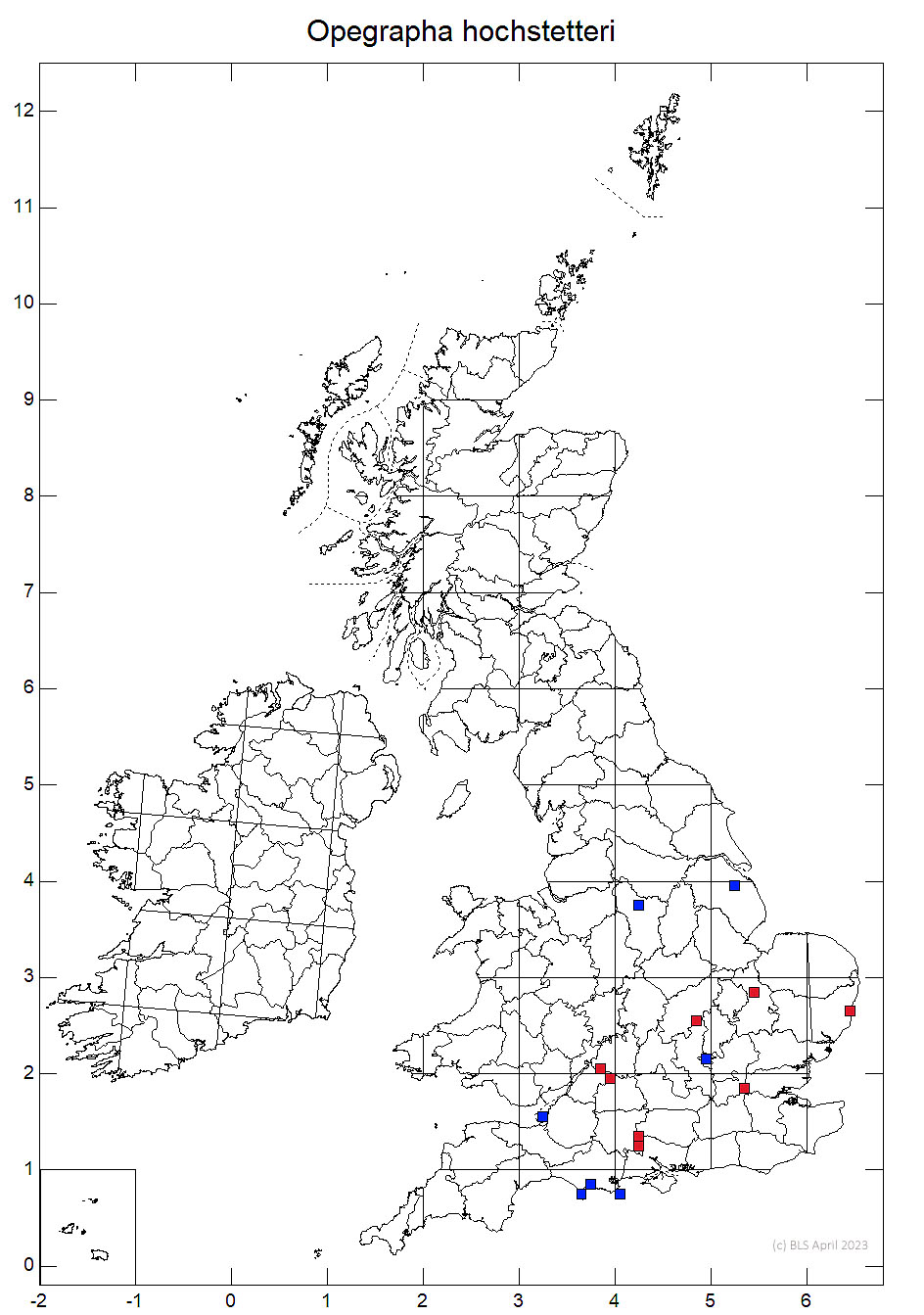A lichenicolous fungus, parasitic on thalli of Verrucaria hochstetteri Fr. and V. muralis Ach. but showing few if any signs of damage; similar to O. opaca Nyl. but differing principally in the somewhat larger dimensions of the ascospores, asci and hymenium height, and the larger but less tightly compacted ascomatal clusters. Found the hosts on calcareous rock and stonework, mostly on worked stone in graveyards etc.
Thallus absent (lichenicolous). Ascomata often forming loose rounded clusters, 0.4–1.2 mm diam. with more irregular clusters to 1.8 × 1.4 mm, and to 0.4 mm high; clusters with 2 to ca 20 ascomata. Individual ascomata usually discernible, black, not pruinose,
lirellate, unbranched or shortly 1–2-furcate, mainly not open but sometimes a few open around the centre exposing the non-pruinose disc, 0.2–0.5 (–0.7) mm long, (0.1–) 0.15–0.2 mm broad and 0.16–0.2 mm tall in section. Exciple well-developed, entire, 36–48 μm wide laterally, dark brown to blackish brown, K– or K+ reddish enhancing (never greenish). Hymenium 50–62 μm tall, hyaline, I+ red to reddish brown, K/I+ blue; epithecium well-developed, brownish and I+ blue, 19–24 μm tall. Subhymenium 12–28 μm tall, slightly brownish, K–. Paraphyses sparingly branched, 1.4–2 μm diam. (in KOH), with slightly swollen tips to ca 3.5 μm diam., which are covered with abundant minute brown granules. Asci broadly clavate, 48–61 × 16–17 μm, with a K /I+ blue ring around the top of the ocular chamber, (4-) 6 (- 8) spored. Ascospores long remaining colourless, 3-septate, the upper two or only the cell second from the top somewhat more swollen than the lower cells, (15–) 16–19 × (4.7–) 5–6 μm whilst colourless, old brown ascospores to 21 μm long and 7 μm diam., usually with a distinct perispore 1–2 μm thick; surface of old spores released from the asci minutely warted (at ×1000), but without brown granules in the perispore. Pycnidia ca 80 μm diam., immersed in the host thallus, with a dark brown wall, conidiogenous cells elongate-ampulliform, 8– 12 × ca 2 μm; conidia aseptate, bacilliform to narrowly ellipsoidal, colourless, 4.3–4.8 × ca 1 μm.
This species is similar to Opegrapha opaca, but differs principally in the somewhat larger dimensions of the ascospores, asci and hymenium height, and the larger, but less tightly compacted ascomatal clusters. O. rupestris (on Bagliettoa species) has 8-spored asci and slightly broader ascomata.
Parasitic on thalli of Verrucaria hochstetteri Fr. and V. muralis Ach., showing few if any signs of damage; on calcareous rock and stonework.

Southern and eastern England, also recorded from Luxembourg, probably elsewhere.
Coppins, B.J., Kondratyuk, S.Y., Etayo, J. & Cannon, P.F. (2021). Notes on lichenicolous species of Opegrapha s. lat. (Arthoniales) on Arthoniaceae and Verrucariaceae, with a key to British and Irish lichenicolous Opegraphaceae. Lichenologist 53: 159-169.
Cannon, P., Coppins, B., Ertz, D., Fletcher, A., Pentecost, A. & Simkin, J. (2021). Arthoniales: Opegraphaceae, including the genera Llimonaea, Opegrapha, Paralecanographa and Sparria. Revisions of British and Irish Lichens 13: 1-19.
